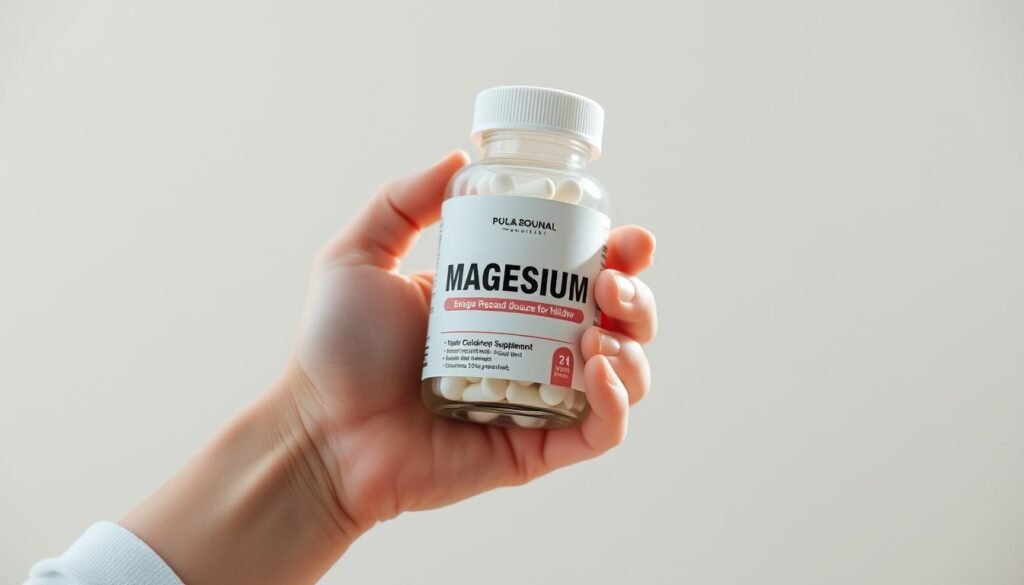Parents often wonder whether their little ones need extra magnesium for optimal growth. This essential mineral supports bone strength, muscle function, and even mood stability in children. Yet, concerns about safety and proper dosage remain top of mind.
Modern diets sometimes fall short due to soil depletion and processed foods. While most youngsters get enough through balanced meals, some may require supplements. The USDA provides clear guidelines for daily intake based on age groups.
Research suggests a link between low levels and conditions like ADHD. However, excessive amounts can also cause issues. Finding the right balance between food sources and supplements is key for long-term health.
Key Takeaways
- Magnesium plays a vital role in bone development and nervous system function.
- Dietary sources like nuts and leafy greens should be prioritized.
- Supplements may help when dietary intake is insufficient.
- Overconsumption can lead to digestive discomfort or other side effects.
- Consult a pediatrician before starting any new supplement regimen.
Why Magnesium Matters for Kids
Growing bodies rely on magnesium for critical biological processes. This nutrient acts as a building block for bones, muscles, and even brain health. Without enough, key functions like energy production and nerve signaling can falter.
The Role of Magnesium in Growth and Development
During adolescence, magnesium contributes to 50% of skeletal structure formation. It partners with calcium and vitamin D to mineralize bones, ensuring sturdy frames for growth spurts. Studies also link optimal levels to fewer growing pains and fractures.
Beyond bones, this mineral aids protein synthesis for tissue repair. It helps convert food into energy, fueling active lifestyles. For teens, balanced magnesium supports hormonal changes and immune system resilience.
Key Bodily Functions Supported by Magnesium
Over 300 enzymatic reactions depend on magnesium. It regulates heart rhythm, prevents muscle cramps, and maintains steady blood sugar. The nervous system benefits too, as magnesium calms stress responses by balancing neurotransmitters.
Research highlights its role in focus and mood stability. Children with ADHD often show improved symptoms when magnesium levels rise. Even digestion relies on this mineral to process nutrients efficiently.
From heartbeats to homework, magnesium quietly powers development. Pairing magnesium-rich foods with mindful supplementation ensures young bodies thrive.
Can Kids Take Magnesium Safely?
Balancing magnesium intake requires understanding age-specific needs. The USDA provides clear guidelines to ensure safety while meeting nutritional demands. Both deficiency and excess pose risks, making informed choices essential.
Age-Appropriate Magnesium Dosage Guidelines
Daily needs vary by age. For children 1–3 years, 80mg is recommended, while 4–8 years need 130mg. Preteens (9–13 years) require 240mg. These values account for growth spurts and metabolic changes.
Supplements have stricter limits. The “tolerable upper intake” caps at 65mg for toddlers and 110mg for ages 4–8. Exceeding these amounts may cause side effects like diarrhea or lethargy.
Risks of Too Much or Too Little Magnesium
Insufficient much magnesium may trigger restless legs, anxiety, or constipation. Studies link deficiencies to hyperactivity, prompting some doctors to prescribe 400mg/day for ADHD management under supervision.
Overconsumption risks toxicity, especially with flavored gummies that tempt overuse. Splitting doses enhances absorption and reduces stomach upset. Always consult a pediatrician, as magnesium interacts with some medications.
Storage Tip: Keep supplements locked away to prevent accidental overconsumption. Pairing magnesium with vitamin B6 may improve effectiveness, as shown in hyperexcitability case studies.
Benefits of Magnesium for Children
Many parents overlook the powerful impact magnesium has on their child’s daily well-being. This mineral supports everything from restful nights to focused school days, often bridging gaps that diet alone can’t fill.
Improved Sleep Quality and Relaxation
Magnesium boosts melatonin production by 30%, helping regulate sleep cycles naturally. Transdermal options like bath flakes or lotions absorb quickly, easing bedtime resistance. Parents report fewer night wakings when magnesium-rich routines replace sugary snacks before bed.
Support for Bone and Muscle Health
Active children benefit from magnesium’s role in bones and muscle recovery. It reduces growing pains by relaxing tense fibers and strengthens tooth enamel to prevent cavities. A half-cup of all-bran cereal delivers 93mg, pairing well with calcium for skeletal support.
Enhanced Mood and Concentration
The Hemamy study found 78% of participants with ADHD saw symptom improvement with 400mg daily. Magnesium stabilizes dopamine, aiding mood and concentration. Less screen-time eye strain and steadier energy levels further highlight its cognitive perks.
Whether through diet or supplements, magnesium’s benefits ripple across a child’s health. Always tailor intake to age and needs for optimal results.
Dietary Sources of Magnesium for Kids
Smart food choices can naturally boost essential mineral intake. Many everyday foods pack impressive magnesium content without requiring supplements. Building a varied diet ensures steady absorption throughout the day.
Magnesium-Rich Foods Kids Will Love
One ounce of cashews delivers 74mg – nearly 20% of a teen’s daily need. Creamy almond butter on whole-grain toast makes a perfect after-school snack. For younger children, nut butters avoid choking hazards while providing the same benefits.
Leafy greens like spinach offer 78mg per half-cup when cooked. Try blending them into fruit smoothies for picky eaters. Black beans and other legumes provide 60mg per serving, perfect for taco nights.
Creative Ways to Incorporate Magnesium into Meals
Roasted chickpeas make crunchy snacks with 48mg per quarter-cup. Pair them with yogurt for extra absorption. Half a banana adds 16mg to oatmeal or pancakes, while avocado slices contribute 11mg per quarter fruit.
Modern farming has reduced mineral content in some produce. Opt for organic when possible, and consider frozen spinach which retains 90% of its nutrients. Soaking nuts overnight improves magnesium availability by reducing phytates.
Simple combinations boost intake significantly:
- Whole-grain cereal with sliced bananas
- Hummus with veggie sticks
- Dark chocolate-covered almonds (for older children)
These foods create a foundation for healthy growth without relying solely on supplements. With clever preparation, even the pickiest eaters can enjoy magnesium-packed meals.
When to Consider Magnesium Supplements
Nearly half of American children fall short on magnesium intake, according to recent studies. While food sources are ideal, certain situations warrant supplements. Knowing the signs helps parents address gaps without overcorrecting.
Signs Your Child Might Need a Supplement
Chronic constipation and frequent growing pains top the red-flag list. Restless sleep or muscle twitches may also indicate needs. A red blood cell (RBC) magnesium test provides definitive answers when symptoms persist.
Transdermal options like Epsom salt baths absorb 60% faster than oral supplements. This form bypasses digestive upset, making it ideal for sensitive stomachs. Pediatricians often recommend it alongside dietary changes.
Choosing the Right Magnesium Supplement for Kids
Glycinate form minimizes laxative effects, while citrate aids digestion. Brands like Natural Vitality and ChildLife offer child-friendly options. Avoid gummies with artificial colors that counteract benefits.
Liquid supplements allow precise dosing adjustments. Morning administration supports focus, while bedtime doses improve relaxation. Always verify insurance coverage for clinically diagnosed deficiencies.
Potential Risks and Side Effects
While magnesium offers numerous benefits, awareness of potential risks ensures safe usage. Even essential minerals become problematic when consumed excessively or improperly. Parents should recognize warning signs and prevention strategies.
Understanding Magnesium Toxicity in Children
The body signals excess intake through progressive symptoms. Mild cases begin with nausea and diarrhea at 5mg per kg body weight. These laxative effects often prompt discontinuation before severe issues arise.
Doses exceeding 15mg/kg may cause dangerous hypotension. Advanced toxicity progresses to muscle weakness, irregular heartbeat, and even coma. Immediate medical attention becomes critical when these symptoms appear.
How to Avoid Over-Supplementation
Prevention starts with understanding supplement labels. The “elemental magnesium” amount matters most, not the compound weight. A pediatrician can help calculate appropriate doses based on age and weight.
Some medications interact negatively, including certain antibiotics and acid reducers. Always disclose all supplements during medical consultations. The FDA warns against unregulated products making unrealistic claims.
For emergencies, keep the Poison Help hotline (1-800-222-1222) accessible. Create a “mineral budget” tracking food sources and supplements. This prevents accidental over-supplementation while meeting nutritional needs.
Conclusion
Magnesium quietly powers key aspects of childhood development. From strong bones to steady moods, this mineral supports milestones. Prioritize nuts, greens, and whole grains in your child’s diet before considering supplements.
Always consult a pediatrician. The AAP warns against guessing deficiencies. For peace of mind, download our magnesium tracker to monitor food intake and health trends.
New IV therapy research shows promise, but food and careful supplementation remain safest. Start small—try avocado toast or almond butter snacks today.
FAQ
Why is magnesium important for growth and development?
Magnesium supports strong bones, muscle function, and a healthy nervous system. It also helps regulate energy production and aids in nutrient absorption, making it essential for growing bodies.
What are the signs of low magnesium levels in children?
Fatigue, muscle cramps, irritability, and poor sleep quality may indicate a deficiency. In severe cases, irregular heartbeat or weakened immunity can occur.
How much magnesium should a child consume daily?
Dosage varies by age: 1-3 years need 80mg, 4-8 years require 130mg, and 9-13 years should get 240mg. Teens need 360-410mg, depending on gender.
Which foods naturally contain high magnesium levels?
Dark leafy greens like spinach, nuts (especially almonds), seeds (pumpkin, chia), legumes, whole grains, and bananas are excellent sources.
Are magnesium supplements safe for children?
Most pediatricians recommend food sources first. If supplements are needed, choose child-friendly forms like magnesium glycinate or citrate, and always consult a doctor first.
Can magnesium help with sleep problems in children?
Research suggests it may improve sleep quality by supporting relaxation and regulating melatonin production. However, dietary adjustments should be tried before supplementation.
What are the risks of excessive magnesium intake?
A> Overconsumption may cause diarrhea, nausea, or abdominal cramps. Extremely high doses could lead to dangerous drops in blood pressure or irregular heart rhythms.
How can I add more magnesium to my child’s diet without supplements?
Blend spinach into smoothies, use almond butter on whole-grain toast, or sprinkle pumpkin seeds on yogurt. Fortified cereals and oatmeal also boost intake.









